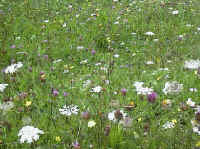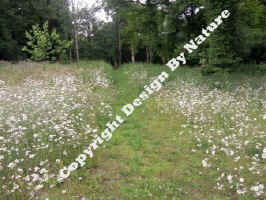|
Sandro's Irish Wildflower Conservation Grade Seed Mixture: Range: Designer Wild Flower Mixtures (Code DW)
Product Name: Cut and Sow. Sow direct into existing meadow or lawns Product Code: DW04 If purchasing this seed mix, print or save this page and keep it as your reference as the species and advice change occasionally
Description: Not for the faint hearted!!!! We have so many easier mixtures, why would you....want this one???????
This mixture is very difficult to establish even for professionals. the results are far less and less species can establish this way. You will not get annuals flowing in the first year, unless you do a really good job to cut away as much grass as possible. We sell this mix mainly to professionals who try to introduce more flora into an existing meadow with wild species that its better not to kill.
The 'Cut and Sow Mix' is a simple 'limited in species mixture', that can be sown directly into existing meadows, worn grass swords and poor lawns DW04 can be sown straight into existing swards, by over sowing, stitching or high spec' slot seeding.
This mixture is designed for dry soils, we make 'Bespoke special mixes' for wet soils
In the first and maybe second year, you will have to cut the grass to 4" / 10cm each month in spring and late summer after sowing, saying this you also have to let the Yellow Rattle flower and go to seed in mid summer. This requires perfect timing.
The aim to stop the grass smothering the wildflower seed. Yet have the grass and flora high enough for Rattle to grow. In year two, stop cutting in early June. so to let it flower from mid June into July, but do not ever let the grass over grow the flora or the grasses will kill the seedlings. As Rattle usually sets seed by Late July, cut down again in August in Year 1 and 2.
Seedling germinate from the original packet keep germinating up to 2 years after sowing. The first emerge three weeks after sowing and then each Spring and Autumn for years after, That's why the meadow must be kept open and short.
It is no use trying to sow into a dense sword or lawn, instead use a non residual weed killer or a mix of soap, vinegar and salt, search internet. The Best way is to cut the grass very short, remove all dead materials and pin or tine harrow the surface to scratch the soil to accept the seeds.
Please study the following carefully..... This mixture contains Yellow rattle as the main species to control grass growth. esp' if Autumn or early spring sown, as Rattle will germinate easily on the bare soil. If summer sown, Rattle will have to be added in Autumn. Yellow Rattle controls most grasses, bar couch grass. If sowing in a warn spring or summer, which can be great for rapid germination, Rattle germination will be poor, so sow Rattle again in Autumn.
Establishment: Kill weeds, specially white clover, dock, thistle and couch grass.
Then cut down / mow the existing grass as low as is possible, to what's called 'zero grazed' to remove all the green grass and remove any dead grass thatch or dead 'straw' materials, the lawn should look like bare soil. But the roots of the grass will be under the soil waiting to grow The grass will be still alive but under the soil, so the soil surface has to be as exposed as possible to accept the seeds and have enough space for them to grow.
If there is a lot of vegetation, Cut it again before the harrow
Once cut down to the 'scut' Rake/harrow the ground to scratch the surface, sometimes easier said than done, and sow the seed as soon as you can, while the grass is below soil. Rake, Roll or press the seed into the ground.
Await for grass to re-emerge, then cut down to 10cm to 14cm, do not cut into the seedling flora. that's about 3 to 5 cuts per year depending on fertility
DO NOT
LET THE GRASS SMOTHER THE SEEDLINGS. Do Not Cut in Mid or High Summer Small Gardens: For small areas, use strimmer, rotary and mulch mowers to reduce and remove the grass the operation can be followed by a cultivator passed over the soil at lowest throttle to scratch the surface. We use a rake, in very small areas. For
large areas: Employ a chain, tine
or pin harrow or specialist contractors with 'one pass seeder
machines' which will kill narrow bands of grass to allow the seed to be
sown, the ground can also be harrowed, roll the seed into the
surface.
SEED SOWING: Try to sow the seed in early spring or late Autumn, to establish the Yellow Rattle, Sowing is best when the grass is not growing, and there is moisture in your soil. Sow into the bare soil that you have scored and roll and or rake the seed into the surface. Record the date of sowing and exactly 5 weeks later if there is grass growth, cut to 6 cm and again in 5 weeks cut to 10 cm and remove the cuttings.
If the grass tops the germinating flora, cut again into late September to 10cm.
It is important to try and carry
out any such work just before rain is due. Additional Options: If sowing into existing grass swards, Individual species of Seeds, Wildflower Plugs, Plants and Planteens can also be sown into the sword at the same time, as the establishment and maintenance will be the same, these can be placed where they will best grow. We have seen
a lot of failures with this method as the grass rarely gets cut after planting,
even when sowing plants, the grass has to be cut to allow them space to
grow. seeds are far easier and cheaper. Harebell is ideal for such single species introductions as the seed is expensive and difficult to establish.
Mixture Specifications:
Species
List:
Birdsfoot Trefoil, Black Meddick, Century,
Cowslip, Devils bit Scabious, Meadow Buttercup, Field Scabious, Kidney Vetch, Lady's Bedstraw,
Lesser Knapweed, Marjoram, Ox-eye Daisy, Red Clover, Ribwort Plantain,
Smooth Hawksbit, Sorrel, St Johnswort, Wild Carrot, Yarrow, Iris. Burnet Saxifrage can be added. Wet soil mixtures includes Fleabane, Water Avens, Wild Valerian, Meadowsweet and more....
This photograph is one day in the life of an ever changing meadow.
Seed Sowing Rates:
Grass seed or nurse crop requirement: Nurse
Crop: A nurse crop is not required |
Product Warning: DBN recommends that this mixture is not for human or animal consumption. Product Warning
Your purchase: Contributes to DBN's work of creating crops of Conservation Grade - Native Origin Wild flora.
You help us
to inform and pay land-owners to manage native species and to assist DBN in
handing on our heritage for another generation.
By growing (some will be difficult) these and all other species, you directly
help to conserve national and global Biodiversity and protect wildlife.
You should also consider yourself another Irish wildflower grower.
Email: info@wildflowers.ie
Last updated on 09/03/2022

